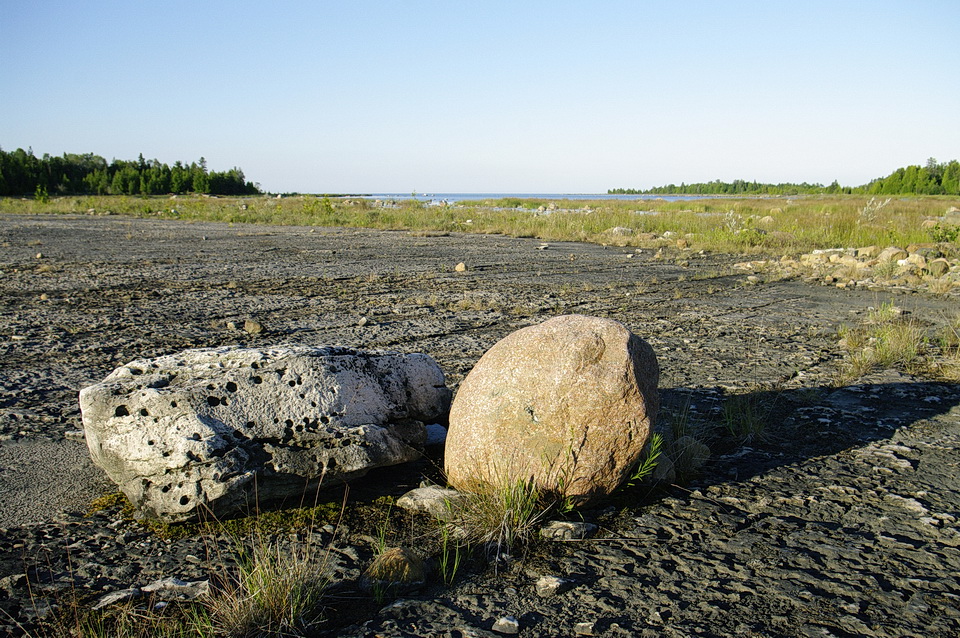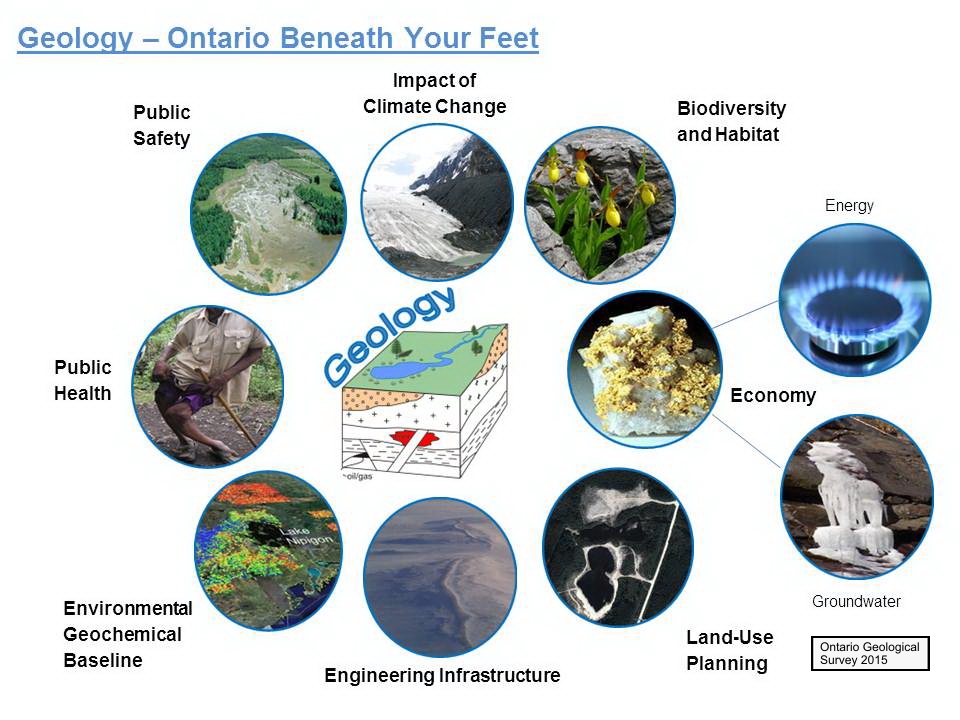Boulders of granite and quartzite, called glacial erratics, which are part of Ontario's geological curiosities. The boulders are of Precambrian-aged rock, more that 1 billion years old. The boulders are out of place. They sit on flat-lying Silurian-aged dolomite, about 430 million years old, which is a completely different rock type. The boulders originated to the north and were carried south to Manitoulin Island by the glacier during the last ice age. When the glacier melted, it left the boulders on the flat-lying Silurian-aged dolomite. The site is Murphy Point, Manitoulin Island. There could be as much as 2 billion years difference in age between the old Precambrian rock and the young Silurian rock. Photo by Andy Fyon, July 11, 2010.
Welcome to Canada Beneath Our Feet (formerly Ontario Beneath Our Feet) - a site devoted to sharing exciting insights about some of those geological curiosities that you come across in parts of Canada or that affect Canada - like the boulders in the photograph. Perhaps you are a geo-tourist. Perhaps you are just driving from and are interested in an area that you are near. If so, you may find something of interest to you in this website. This website is intended for non-technical people. You do not have to be a geologist to learn something new from this website.
Through this website, I present information describing the cool geological sites located in, or that affect, Canada. The information I provide is researched by others, supported by some of my own photos and my own observations. I try to translate that information to tell a story that will help convey the interest and importance of Canada’s geology. I hope those insights will help to raise your interest and understanding of some of Canada geology - the Canada Beneath Our Feet.
I am not an expert on most of the topics that I discuss on this website. For some of the topics, there is debate. I am not providing advice about the application of geology to solve a specific problem you may have. For that kind of advice, please seek the service of a Professional Geoscientist who is expert in that topic.
I have visited almost all of the locations described here. Many are accessible by car or by hike. Some are remote and not easily accessible. I have included the less accessible locations because they tell an important part of Canada's geological history. I selected many of the sites because they show a geological feature, or because they tell an interesting geological story.
There are other excellent sources of Canada’s geological information - just "Google" "Canada Geology".
Andy Fyon sitting on the edge of a geological feature - a hole - called a pothole. The pothole was formed perhaps 10,000 years ago during, and at the end of, the last great ice age when rushing water carried pebbles that drilled into the rock. At that time, this rock surface was the floor of a rushing river fed by glacial meltwater. Location: Warsaw Caves Conservation Area. Photo by E. Ginn, 2016.
What is Geology:
The science of "Geology" is the study of the Earth. Geologists study the processes that formed the Earth, including the rocks and the deposits laid down by rivers and glaciers, the processes that shaped the Earth, including erosion and glaciation, the role of glaciers over time in shaping the surface of the Earth during the most recent times, and why this information and history is relevant to all of us.
Understanding Canada’s geology helps us appreciate the beauty and physical history of Canada and helps us understand the amazing processes that formed many of the land forms that are now popular tourist destinations. Knowledge about Canada's geology is also critical to inform: a) decisions related to our health and safety; b) the state and health of the environment; c) impact of climate change on the physical land; d) biodiversity and habitats; e) sources and quality of groundwater; and f) physical engineering of structures and infrastructure like roads and communities. Let me be blunt: we cannot plan for our future without understanding our past, including an understanding the Canada Beneath Our Feet, so that we can identify areas of natural geological risk, changes to the environment, and the location of areas having essential natural resources, like groundwater, ground energy, and minerals!
Knowledge about the geology of Canada is critical to inform decisions related to public health and safety, the health of the environment, impact of climate change, biodiversity and habitats, sources and quality of groundwater, minerals and energy, physical engineering of structures and physical infrastructure like roads, and land-use planning.
Remember, if we have an interest in protecting and allocating Canada’s earth resources, including groundwater, to serve public or commercial consumption, the container of those resources is the geology of Canada!
Far North Rambles
I started to add to this website topics entitles “Far North Rambles”. These are short scripts where I recall my experiences as a geologist and a traveler across Canadian Far North localities. Most of these recollections come from Ontario. My intent is partly to share some amusing stories and partly to raise awareness about those First Nation people who live in the remote areas of Ontario, and elsewhere.
Enjoy
Andy Fyon, Sept 25, 2020
Updated: Sept 20/16; Sept 24/16; Oct 27/16; Nov 2/16; Dec 3/16; Feb 5/20; Sept 25/20.



